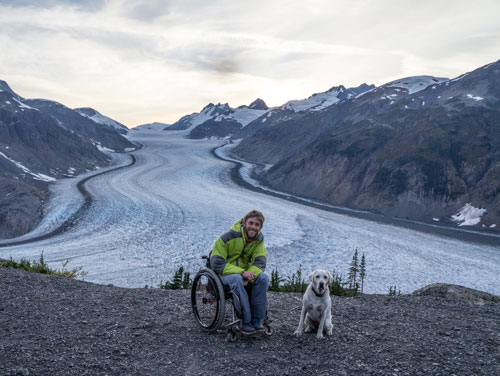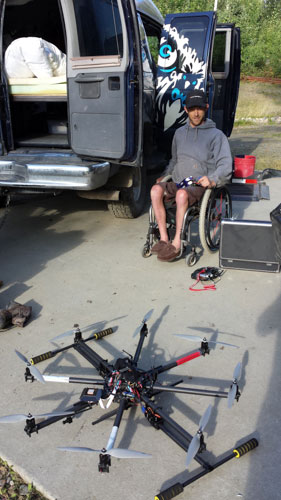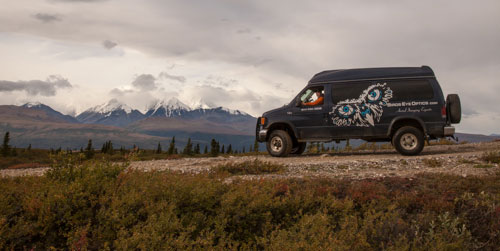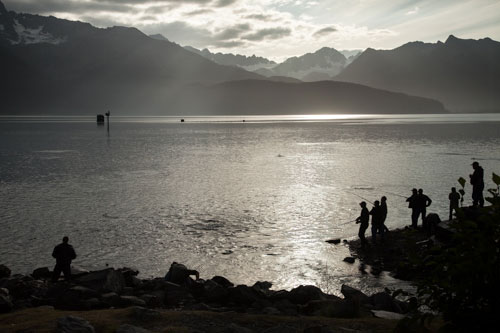I'd always wanted to visit Alaska. My original plan was to graduate from college and ride a motorcycle from my home in Colorado to Alaska and see as much wilderness as I could muster. Unfortunately, when I graduated from college I had neither the motorcycle nor the financial stability to make that trip a reality. Then, of course, I broke my neck and everything changed.

Fast-forward about four years and I received a phone call from one of my best friends telling me he is going to be living in Fairbanks, Alaska for a year before driving back to California. That's all it took to get the gears spinning again. I knew I was finally at a point physically that I could handle such a trip, so the only remaining questions was how?
I thought about flying, but I had recently fallen in love with the idea of living out of a van. Sure, a flight would be the simplest and cheapest way to get there but it would be tough for me to bring all the gear I needed to camp, film, and travel independently. Alternatively, by having a van converted to an RV I had all the medical essentials I needed to not only sustain, but flourish in the backcountry.
After doing a few rough calculations of what it would cost to drive in fuel, I knew this was going to be way more expensive of a trip than I had originally planned! I knew I couldn't swing the cost solely on my own and concluded the best chance for me to raise enough money to do this trip was with a crowdfunding campaign using Kickstarter.

In 2013, I had started an aerial photography business called Birds Eye Optics. I was a photographer long before I used a wheelchair and found using a drone allowed me to still be creative, despite sitting in one place. With this new skill set and business endeavor, I decided making a work/play trip would be the best option to both enjoy and promote my new business. My plan was to capture unseen aerial footage in the backwoods of Alaska while also hanging out with one of my best friends on a once-in-a-lifetime journey.
The process of making a Kickstarter project isn't rocket science. The first thing you have to figure out is what you want to do and how much it would cost to do it. From there, you decide what you can offer to those who pledge to help you achieve your goals, build a compelling video explaining your execution, and lastly: promote, promote, promote!
Phase One: Budgeting

When figuring out a budget, I knew I would need some extra hard drives, money for food, gas, vehicle modifications, and unexpected expenses. There were a lot of other things to consider like lodging, vehicle repairs, etc., but ultimately I just needed a rough number to set the goal. One important thing to note here is how Kickstarter works. When using Kickstarter, if you do not reach your goal, all of the money pledged is returned to the pledgers. For this reason, it's important to set a number that seems reachable but also make sure you have enough to achieve the mission!
Phase Two: Incentivizing
The next step of creating "incentives" took some thinking. Of course, aerial photographs around Alaska was the first thing that came to mind since I was going there to do just that. However, I tried thinking of what other material items did I want to offer that others would appreciate? After considering a few options, I decided that I could make T-shirts and sweatshirts that would show my company logo (and shamelessly advertise for me) as well as a few laser wood carvings that could be interesting wall decorations. It's important during this phase to also calculate how much it is going to cost you to produce any material goods. This goes back to the previous budget phase.
Phase Three: Promoting
The third part of making a Kickstarter is creating a video. After doing an interview explaining why I wanted to go to Alaska, we quickly realized that I'm much better behind the camera than in front of it! We therefore decided to show some of the drone footage I had already captured and added some voiceover and animation explaining the project. I've found through researching other Kickstarter projects that it's not important to have fancy cameras or complex editing to be successful. Instead, you want to focus on why people would want to help you rather than focusing solely on the funding. What does this project mean to you?
Promotion is a funny thing. It was tough for me to swallow my pride since I felt like I was basically saying, "Hey give me money!" But ultimately, I realized that most people feel excitement about helping you succeed in your dreams and aspirations. Many people donated who I had never met or heard of from all over the world! I used Facebook, emails, Instagram, word of mouth, and had as many people share as were willing. After it was complete all I had left was to hit the magical "Begin" button! And so here we go!

I don't want to tell you how this story ends but let's just say it was one of the most magnificent trips of my entire life! Thanks again to all that made Birds Eye Alaska possible!
About the Author
Kirk Williams is a C6-7 quadriplegic adventure photographer who, despite having paralysis from the chest down, refuses to sit still. Even with having limited dexterity, Kirk has created a drone photography business, Birds Eye Optics, that allows him an opportunity to travel, be outside, and do what he loves. Kirk also uses his website to blog, vlog, and explain how he's able to live a fulfilling adventurous life as a quadriplegic. From scuba diving in Mexico or playa dust at Burning Man, to traveling around Alaska in a homemade camper van, Kirk hopes that his skill set and storytelling will persuade others to get out and do more in this beautiful short life we're given.
Kirk's ride is a Quickie 7R.
Most of the stories here on LiveQuickie were submitted by readers. Do you have a story to tell? We'd love to hear it. Submit your story here.